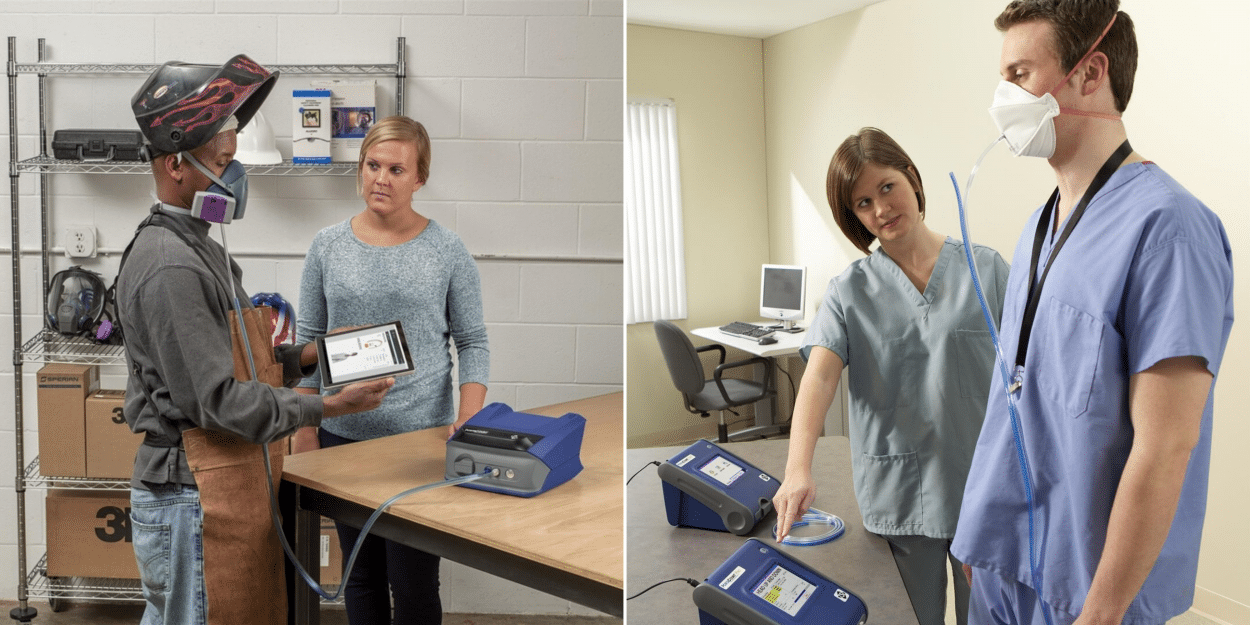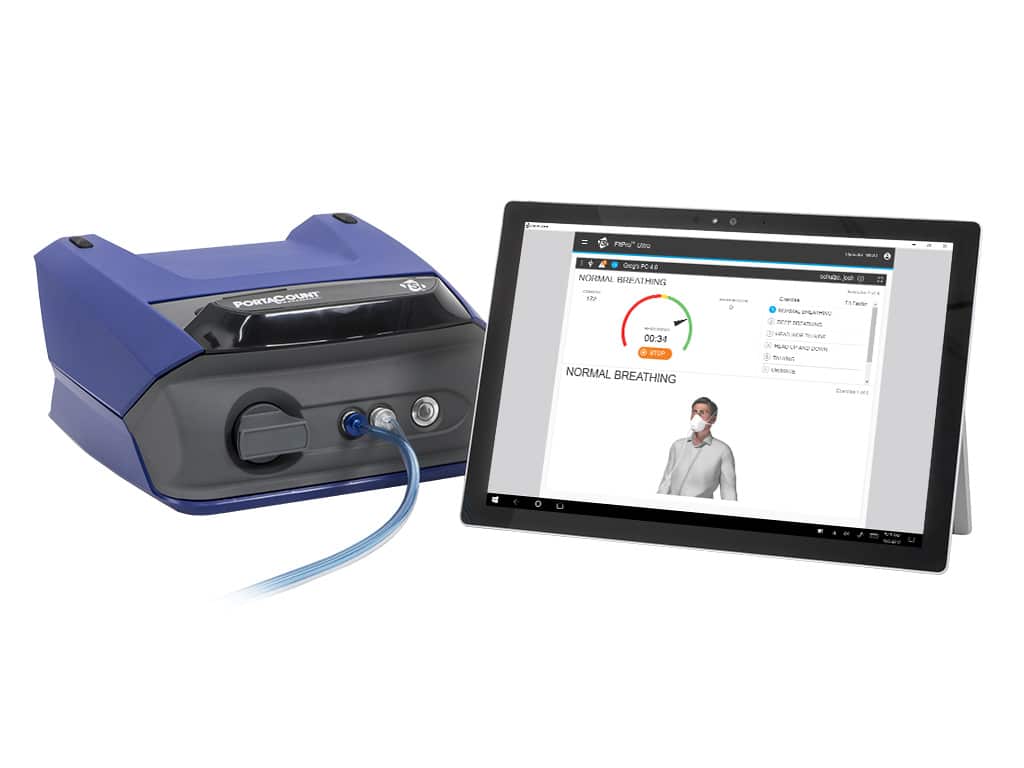Respirators (FFP2/N95) are the masks offering maximum protection against viruses such as COVID-19. And if they do so, it is because they incorporate efficient filters that meet valid standards. But how to make sure those filters meet the binding requirements? Then, when worn, how to make sure the respirators do not leak? Finally, in the current mask shortage situation, how to detect counterfeits? Oliver F. Bischof, Director of Sales – EMEA at TSI explained to us how filter testers and fit testers make sure respirators offer the right protection.
Hicham Dhouibi, technical expert at DirectIndustry, contributed to this article.
Respirators are personal protective equipment (PPE) that offer maximum filtration of particles and droplet aerosols. They are currently massively worn by healthcare professionals fighting COVID-19. They are also widely used in hazardous industrial environments.

Filter Testing
Respirators must meet binding standards (that are different depending on the country) and therefore need to be tested before they go on the market to make sure they are compliant with these standards. TSI provides mask manufacturers, test laboratories and certification bodies a filter tester (Automated Filter Tester Model 8130A) that measures the filtration efficiency of respirators as required by the different national and regional standards.
DirectIndustry magazine: How does filter testing work?
Oliver F. Bischof: There are different classes of filters. In Europe, FFP1 means that the filter’s filtration efficiency takes out 80% of the airborne solid or droplet particles. FFP2 means it filters 94% of the particles. FFP3 does it for 99% of the particles. If you are a mask manufacturer and you want to bring a respirator, a filtering facepiece or a filtering half mask to market, you have to meet the binding legislation. So you need to test your filters for certification, but also quality assurance and quality control.
Testing filters itself is not that difficult. You need an aerosol source, we call it a challenge aerosol, a conditioning to dilute, dry and/or neutralize the aerosol and a filter holder. Then you measure upstream and downstream of that filter with a laser photometer or a particle counter. And the ratio between the signal upstream and downstream gives the filter efficiency. The test takes between 5 and 10 seconds, depending on the model of the tester. Our product family called Automated Filter Tester 8130A can be used to meet European standards but also national Chinese, Japanese and US standards. We have the ability to use the same tester to meet different standards.
(For more info on the respirators’ standards, read our article: Surgical Masks, FFP2, Barrier Masks: Which Masks Actually Protect Against COVID-19?)
DirectIndustry magazine: How different is the testing process depending on the standards?
Oliver F. Bischof: The challenge aerosols differ according to the standards. For example, the US standard requires only sodium chloride as the challenge aerosol. For the EU standard, you need to have sodium chloride and also an oil aerosol such as paraffin. So you need to use the right type of aerosol and the right aerosol characteristics (the mass median diameter and the standard deviation of the challenge aerosol) to make a compliant test. Our tester can be equipped with different types of aerosol generators to make compliant quality control testing according to the local standards. The machine is made to meet respirator testing standards whatever the standards are.
DirectIndustry magazine: So with your machine, a manufacturer can test the same masks to be compliant with different standards.
Oliver F. Bischof: Yes. When you manufacture in China it does not mean that you are only producing for the Chinese market. A respirator is labor-intensive so all the mask manufacturers such as 3M and Honeywell are global companies with big production sites in the Asia Pacific region. So if these companies want to bring respirators to the European market, they have to demonstrate that their production is in line with the European standards. So most manufacturers usually order all types of aerosol generators, and not only the ones required by the country they are in.

DirectIndustry magazine: Can your machines also be used to test surgical masks and the new barrier masks?
Oliver F. Bischof: Surgical masks are not respirators. They are not PPE. So surgical masks and all the homemade masks do not have to meet the valid standards for filtering half masks. And they can’t, either. Of course, we can test their filtration efficiency if we put them into a filter holder. For example, a very good surgical mask, with 3 layers of filtration material, can have a filtration efficiency as high as 80 %. However, most of the ones that people are wearing today have a filtration efficiency of maybe 10 to 30%.
As for the homemade community or barrier masks, they differ widely because they use every piece of cloth. The only purpose they can possibly serve is to create a barrier of what a person exhales to protect others. But they do not provide any reliable protection for the wearer because whatever he/she is inhaling is not properly filtered. Our machines can test everything: masks that are ready to be worn, filter media, media capsules. But our claim is that our machines meet the various global respirator standards.
Fit Testing
Filter testing is essential to ensure a respirator offers the right protection and filtration efficiency that it is expected to provide. But that is not all. A respirator must also be worn correctly and well used to guarantee full protection and minimum leakage. When badly worn, even the best respirator becomes meaningless. It is probably less well known, but fit testers are here to make sure that respirators fit well on a person. TSI has developed the PortaCount Respirator Fit Tester 8040 for that very purpose.
DirectIndustry magazine: Why is fit testing important?
Oliver F. Bischof: As we mentioned earlier, there are different classes of filters, and our filter test products measure their filtration efficiency. But we are only measuring the filtration efficiency, and not how a person is actually protected by a respirator. Which actually should be the most important thing! Yet, respirators and filtering face pieces differ by type, by brands, by model and by size. And not every model fits a person. So even the best respirator may not offer adequate protection depending on how tightly it fits your face and how well it seals. There could, for example, be leakage around the edges of the masks or around the nose. So a high filtration efficiency can be meaningless if the mask is leaking.

DirectIndustry magazine: How does your technology work?
Oliver F. Bischof: The PortaCount 8040 is used with a little tablet computer that shows the person being fit tested all the instructions on the screen. It walks the person through the entire process of putting the respirator on, doing the exercise, and the test. It is easy to follow. The machine even allows you to do the testing yourself, although we recommend that any fit test is done by a competent person. We have a protocol, a fast fit protocol that does the testing in 2.5 minutes. And a Group Fit test mode that allows the administrators to control up to four instruments from a single control screen at the same time.
DirectIndustry magazine: Are there official requirements to fit testing?
Oliver F. Bischof: Leading nations have standards that demand that everybody who wears a respirator for work has to get fit tested. So that the user knows what model, brand, size fits him/her best. This delivers the fit factor and it is important to protect the wearer of a respirator. In the US and in the UK, everybody that has to wear a respirator for work has to be fit tested, like in the healthcare sector. In France and the Netherlands, it is only people working in the asbestos removal and cleanup industries. In the UK there is even a special guideline, you need to be fit tested by a competent person that had extensive training in fit testing. So a competent person has to come on site. Depending on a country’s guidelines, fit tested can be done annually, or at defined intervals.(For more information on fit testing guidelines: https://www.fit2fit.org/)

DirectIndustry magazine: How big is the demand for fit testers today for TSI?
Oliver F. Bischof: We are seeing a drastically increased demand, mainly driven by hospitals because people fighting the virus are only properly protected when fit tested. But there is also an increasing demand for fit testing to verify that the masks are not counterfeit. Because of the shortage of respirators and filtering face pieces all around the world, there is a lot of counterfeit products on the market. They look authentic and might carry the EN 149 reference number. Some even show the CE mark with a notified body number and have certifications, so hospitals spend millions on these products. Once they get them on site, they do the fit test and realize there is something wrong with them. Fit testing is currently the most common way of showing that a shipment of respirators is actually not meeting expectations. If you buy a 3M FFP3 half mask respirator you should expect that it has a fit factor of 100. If a shipment of respirators supposedly made by 3M is tested and fail the fit test, then you know it is most probably counterfeit.








![Image [BUYING GUIDE] How to Choose the Right Laboratory Stirrer?](/wp-content/uploads/sites/3/lab-320x213.png)


